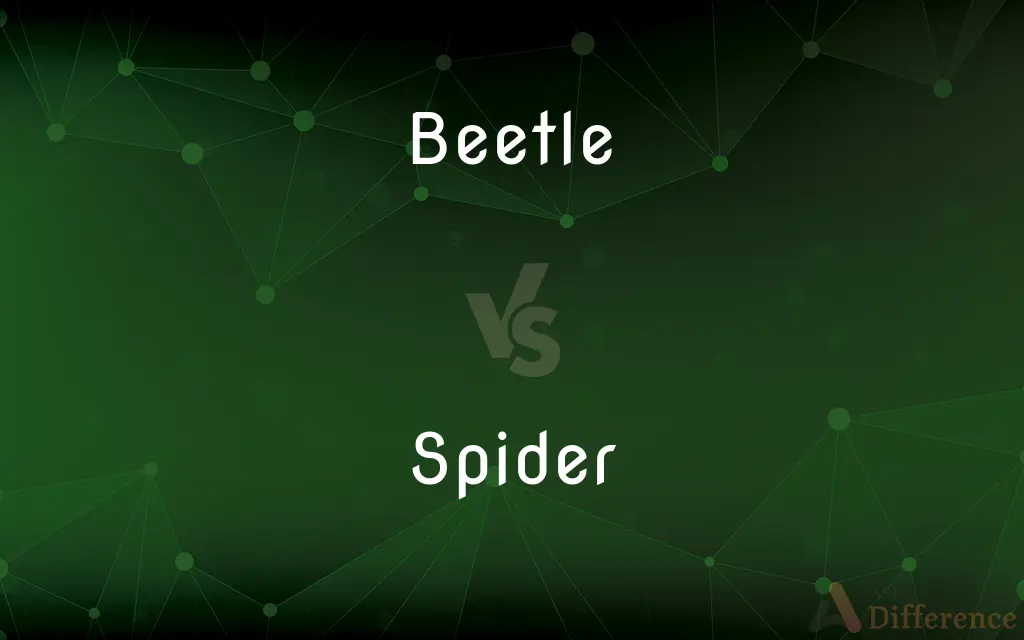Beetle vs. Spider — What's the Difference?
Edited by Tayyaba Rehman — By Fiza Rafique — Updated on April 23, 2024
Beetle and spider differ mainly in taxonomy: beetles are insects with two pairs of wings and a distinct division between their thorax and abdomen, while spiders are arachnids with eight legs and no wings.

Difference Between Beetle and Spider
Table of Contents
ADVERTISEMENT
Key Differences
Beetles are part of the order Coleoptera and are characterized by their hard exoskeleton and forewings modified into protective covers for their secondary wings. Whereas spiders belong to the class Arachnida and are distinguished by having eight legs and chelicerae with fangs that inject venom.
Beetles undergo complete metamorphosis, which includes stages as an egg, larva, pupa, and adult. On the other hand, spiders typically develop through a simpler process, involving several stages of molting from egg to maturity without a pupal stage.
The diet of most beetles primarily includes plant and animal materials, depending on the species. Conversely, spiders are predominantly carnivorous, usually preying on insects and sometimes small vertebrates, using their venom to subdue their prey.
Beetles typically use their wings to escape predators or to migrate, which adds to their mobility. In contrast, spiders often rely on their ability to produce silk for various purposes, including making webs to catch prey, creating shelters, or aiding in locomotion.
The sensory abilities of beetles are diverse, with some species having excellent vision or olfactory senses for detecting pheromones. Spiders, however, generally have poor vision but exceptional tactile senses, primarily through hairs on their legs that detect vibrations and air currents.
ADVERTISEMENT
Comparison Chart
Classification
Insect
Arachnid
Body segments
Three (head, thorax, abdomen)
Two (cephalothorax, abdomen)
Legs
Six
Eight
Wings
Two pairs (one pair hardened)
None
Reproduction
Eggs laid in environment
Eggs in silk cocoons
Compare with Definitions
Beetle
A small to medium-sized insect known for its hard exoskeleton and forewings.
The ladybug, a type of beetle, is prized by gardeners for its ability to control aphids.
Spider
Many species exhibit unique mating dances and rituals.
Male peacock spiders perform an elaborate dance to attract females.
Beetle
Known for their role in pollination and the ecosystem.
Dung beetles play a crucial role in nutrient cycling and seed dispersal.
Spider
Known for their silk-spinning abilities to create webs.
Orb-weaver spiders construct intricate webs that are marvels of biological engineering.
Beetle
Some species are pests, damaging crops.
The Colorado potato beetle is a notorious pest of potato crops.
Spider
Predators, mainly of insects, which they often immobilize with venom.
The jumping spider preys on flies that venture too close to its hiding spot.
Beetle
Any insect of the order Coleoptera, characterized by wing cases.
Beetles are found in nearly every habitat except the sea and the polar ice caps.
Spider
Found in almost every terrestrial habitat and a few aquatic ones.
The water spider creates an underwater air bubble to live and hunt in.
Beetle
Beetles can be either herbivores or carnivores.
The stag beetle uses its large mandibles to fight rivals and attract mates.
Spider
An arachnid with four pairs of legs and no antennae.
Spiders are often feared for their venomous bite, though most are harmless to humans.
Beetle
Beetles are a group of insects that form the order Coleoptera (), in the superorder Endopterygota. Their front pair of wings are hardened into wing-cases, elytra, distinguishing them from most other insects.
Spider
Spiders (order Araneae) are air-breathing arthropods that have eight legs, chelicerae with fangs generally able to inject venom, and spinnerets that extrude silk. They are the largest order of arachnids and rank seventh in total species diversity among all orders of organisms.
Beetle
Any of numerous insects of the order Coleoptera, having biting or chewing mouthparts and forewings modified to form horny coverings that protect the underlying pair of membranous hind wings when at rest.
Spider
An eight-legged predatory arachnid with an unsegmented body consisting of a fused head and thorax and a rounded abdomen. Spiders have fangs which inject poison into their prey, and most kinds spin webs in which to capture insects.
Beetle
An insect resembling a member of the order Coleoptera.
Spider
An object resembling a spider, especially one having numerous or prominent legs or radiating spokes.
Beetle
A heavy mallet with a large wooden head.
Spider
Another term for crawler (sense 2)
Beetle
A small wooden household mallet.
Spider
Move in a scuttling manner suggestive of a spider
A treecreeper spidered head first down the tree trunk
Beetle
A machine with revolving wooden hammers that gives fabrics a lustrous sheen.
Spider
Another term for crawl (sense 4 of the verb)
When the search engines spider your site they'll find all of the pages
Beetle
To make one's way or move like a beetle
"Chambermaids ... beetled from bedroom to bedroom loaded with ... champagne" (Vanity Fair).
Spider
Any of numerous arachnids of the order Araneae, having a body divided into a cephalothorax and an abdomen, eight legs, two chelicerae that bear venom glands, and two or more spinnerets that produce the silk used to make nests, cocoons, or webs for trapping insects.
Beetle
To jut; overhang
"The rocks often beetled over the road" (Washington Irving).
Spider
One that resembles a spider, as in appearance, character, or movement.
Beetle
Jutting; overhanging
Beetle brows.
Spider
A program that automatically retrieves webpages and follows the links on them to retrieve more webpages. Spiders are used by search engines to retrieve publicly accessible webpages for indexing, and they can also be used to check for links to webpages that no longer exist. Also called crawler, search bot.
Beetle
Any of numerous species of insect in the order Coleoptera characterized by a pair of hard, shell-like front wings which cover and protect a pair of rear wings when at rest.
Spider
New England, Upper Northern, & South Atlantic US See frying pan.
Beetle
(uncountable) A game of chance in which players attempt to complete a drawing of a beetle, different dice rolls allowing them to add the various body parts.
Spider
A trivet.
Beetle
Alternative case form of Beetle
Spider
Any of various eight-legged, predatory arthropods, of the order Araneae, most of which spin webs to catch prey.
Beetle
A type of mallet with a large wooden head, used to drive wedges, beat pavements, etc.
Spider
A program which follows links on the World Wide Web in order to gather information.
Beetle
A machine in which fabrics are subjected to a hammering process while passing over rollers, as in cotton mills; a beetling machine.
Spider
A float drink made by mixing ice-cream and a soda or fizzy drink (such as lemonade).
Beetle
To move (away) quickly, to scurry away.
He beetled off on his vacation.
Spider
An alcoholic drink made with brandy and lemonade or ginger beer.
Beetle
To loom over; to extend or jut.
The heavy chimney beetled over the thatched roof.
Spider
(slang) A spindly person.
Beetle
To beat with a heavy mallet.
Spider
(slang) A man who persistently approaches or accosts a woman in a public social setting, particularly in a bar.
Beetle
To finish by subjecting to a hammering process in a beetle or beetling machine.
To beetle cotton goods
Spider
A stick with a convex arch-shaped notched head used to support the cue when the cue ball is out of reach at normal extension; a bridge.
Beetle
Protruding, jutting, overhanging.
Beetle brows
Spider
A cast-iron frying pan with three legs, once common in open-hearth cookery.
Beetle
A heavy mallet, used to drive wedges, beat pavements, etc.
Spider
(cooking) Implement for moving food in and out of hot oil for deep frying, with a circular metal mesh attached to a long handle; a spider skimmer
Beetle
A machine in which fabrics are subjected to a hammering process while passing over rollers, as in cotton mills; - called also beetling machine.
Spider
(cycling) A part of a crank, to which the chainrings are attached.
Beetle
Any insect of the order Coleoptera, having four wings, the outer pair being stiff cases for covering the others when they are folded up. See Coleoptera.
Spider
Heroin.
Beetle
To beat with a heavy mallet.
Spider
(music) Part of a resonator instrument that transmits string vibrations from the bridge to a resonator cone at multiple points.
Beetle
To finish by subjecting to a hammering process in a beetle or beetling machine; as, to beetle cotton goods.
Spider
A skeleton or frame with radiating arms or members, often connected by crosspieces, such as a casting forming the hub and spokes to which the rim of a fly wheel or large gear is bolted; the body of a piston head; or a frame for strengthening a core or mould for a casting.
Beetle
To extend over and beyond the base or support; to overhang; to jut.
To the dreadful summit of the cliffThat beetles o'er his base into the sea.
Each beetling rampart, and each tower sublime.
Spider
A soft-hackle fly.
Beetle
Insect having biting mouthparts and front wings modified to form horny covers overlying the membranous rear wings
Spider
(sports) The network of wires separating the areas of a dartboard.
Beetle
A tool resembling a hammer but with a large head (usually wooden); used to drive wedges or ram down paving stones or for crushing or beating or flattening or smoothing
Spider
(maths) A spider graph or spider tree.
Beetle
Be suspended over or hang over;
This huge rock beetles over the edge of the town
Spider
(obsolete) A type of light phaeton.
Beetle
Fly or go in a manner resembling a beetle;
He beetled up the staircase
They beetled off home
Spider
(photography) A support for a camera tripod, preventing it from sliding.
Beetle
Beat with a beetle
Spider
(lawn bowls) A competition in which several participants are spread evenly around the edges of the green, who all make one bowl towards the central jack at the same time; the winner being the person whose bowl ends up closest to the jack.
Beetle
Jutting or overhanging;
Beetle brows
Spider
To move like a spider.
Spider
To cover a surface like a cobweb.
Spider
To follow links on the World Wide Web in order to gather information.
The online dictionary is regularly spidered by search engines.
Spider
Any one of numerous species of arachnids comprising the order Araneina. Spiders have the mandibles converted into poison fangs, or falcers. The abdomen is large and not segmented, with two or three pairs of spinnerets near the end, by means of which they spin threads of silk to form cocoons, or nests, to protect their eggs and young. Many species spin also complex webs to entrap the insects upon which they prey. The eyes are usually eight in number (rarely six), and are situated on the back of the cephalothorax. See Illust. under Araneina.
Spider
Any one of various other arachnids resembling the true spiders, especially certain mites, as the red spider (see under Red).
Spider
An iron pan with a long handle, used as a kitchen utensil in frying food. Originally, it had long legs, and was used over coals on the hearth.
Spider
A trevet to support pans or pots over a fire.
Spider
A skeleton, or frame, having radiating arms or members, often connected by crosspieces; as, a casting forming the hub and spokes to which the rim of a fly wheel or large gear is bolted; the body of a piston head; a frame for strengthening a core or mold for a casting, etc.
Spider
Predatory arachnid that usually has silk-spinning organs at the back end of the body; they spin silk to make cocoons for eggs or traps for prey
Spider
A computer program that prowls the internet looking for publicly accessible resources that can be added to a database; the database can then be searched with a search engine
Spider
A skillet made of cast iron
Common Curiosities
How do beetles and spiders reproduce?
Beetles lay eggs, often in the soil or on plants; spiders lay eggs in silk cocoons, sometimes carried or guarded by the mother.
What are the primary diets of beetles and spiders?
Beetles might be herbivores, carnivores, or omnivores; spiders are generally carnivores.
Can both beetles and spiders fly?
Most beetles can fly using their hind wings, but spiders do not have wings and cannot fly.
How do beetles and spiders sense their environment?
Beetles use a variety of senses including vision and smell; spiders primarily use tactile senses through their leg hairs.
What distinguishes a beetle's body structure from that of a spider?
Beetles have a segmented body with three parts and six legs, while spiders have a two-part body and eight legs.
What roles do beetles play in the ecosystem?
Beetles serve many roles, including pollinator, decomposer, and predator or prey in various ecosystems.
How do spiders contribute to controlling pests?
Spiders help control insect populations, making them beneficial in natural pest management.
Why do spiders spin webs?
Spiders spin webs primarily for catching prey, although they also use silk for shelter and to facilitate movement.
What is the significance of the hard forewings in beetles?
The hard forewings in beetles protect their secondary wings and add to their body's defense.
What are some common habitats for beetles?
Beetles are versatile and inhabit diverse environments from forests to deserts.
Are all spiders venomous?
Nearly all spiders possess venom for subduing prey, but most are not dangerous to humans.
Can beetles be beneficial to agriculture?
Yes, many beetles, like ladybugs, help control agricultural pests.
What is unique about spider silk?
Spider silk is incredibly strong and versatile, used for making webs, cocoons, and other structures.
How do temperature and climate affect beetles and spiders?
Both are ectothermic, but beetles can often survive colder temperatures by hibernating, while spiders may seek shelter or die off in freezing conditions.
Do spiders have any predators?
Yes, spiders are preyed upon by birds, reptiles, amphibians, and even other spiders.
Share Your Discovery

Previous Comparison
Precedent vs. Antecedent
Next Comparison
Lounge vs. LobbyAuthor Spotlight
Written by
Fiza RafiqueFiza Rafique is a skilled content writer at AskDifference.com, where she meticulously refines and enhances written pieces. Drawing from her vast editorial expertise, Fiza ensures clarity, accuracy, and precision in every article. Passionate about language, she continually seeks to elevate the quality of content for readers worldwide.
Edited by
Tayyaba RehmanTayyaba Rehman is a distinguished writer, currently serving as a primary contributor to askdifference.com. As a researcher in semantics and etymology, Tayyaba's passion for the complexity of languages and their distinctions has found a perfect home on the platform. Tayyaba delves into the intricacies of language, distinguishing between commonly confused words and phrases, thereby providing clarity for readers worldwide.














































